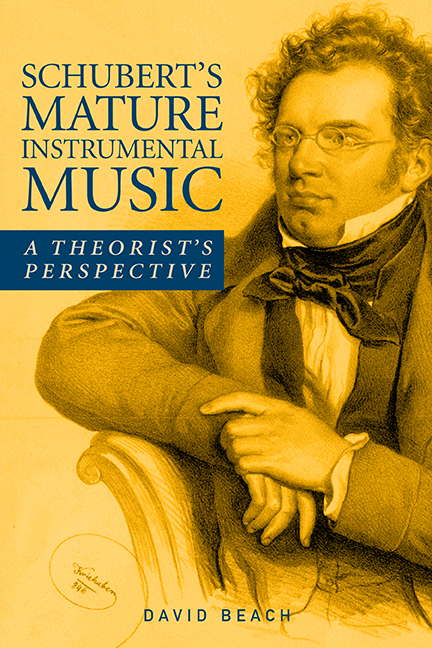Epilogue: Thoughts on Schubert’s Mature Instrumental Style
Published online by Cambridge University Press: 10 June 2021
Summary
This entire book has been about the characteristics of Schubert's mature instrumental style, presented either directly, as in the opening chapters, or indirectly, through a series of analyses. Some of these characteristics appear only in his late works, while others are found, to a lesser extent, in his earlier works, as well. I will summarize my observations briefly in the following paragraphs, beginning with his treatment of form.
It seems that one area that occupied Schubert throughout his career was striving to find solutions to formal/tonal organization, particularly in relation to sonata form. We can see this in some of his earlier works, like the Symphony no. 2 in B-flat Major, D. 125 (1815). The exposition from the first movement of this work has the unusual formal/tonal scheme of theme 1 (B♭)–theme 2 (E♭)–theme 1 repeated (F); the recapitulation answers with theme 1 (E♭)– theme 2 (B♭)–theme 1 (B♭). Later this type of construction would manifest itself in the three-theme/three key exposition in the first movements of such works as the Piano Trio in E-flat Major, the Piano Sonata in B-flat Major and the String Quintet in C Major. As important as this innovation may be, Schubert's most radical and pervasive innovation in this area is the idea of transposing the key relationships from the exposition into the recapitulation to end, rather than begin, on the tonic. This led to some extreme examples, like the second movement of the “Trout” Quintet, but more frequently appeared in movements where the key scheme of I to V from the exposition was answered by IV to I in the recapitulation (the “subdominant recapitulation”), as in the first movements of the Symphony no. 5 (1816) and the “Trout” Quintet (1819). What I find particularly fascinating is that Schubert seems to have combined this procedure with the traditional practice of beginning the recapitulation in the tonic key in some of his late works, like the first movements of the Octet, the String Quintet and the Quartet in G Major. In all these movements, the recapitulation begins on the tonic, but this tonic is soon transformed into V of the subdominant, from which point the remainder of the recapitulation proceeds in large part as a transposition of the exposition.
- Type
- Chapter
- Information
- Schubert's Mature Instrumental MusicA Theorist's Perspective, pp. 196 - 199Publisher: Boydell & BrewerPrint publication year: 2017



